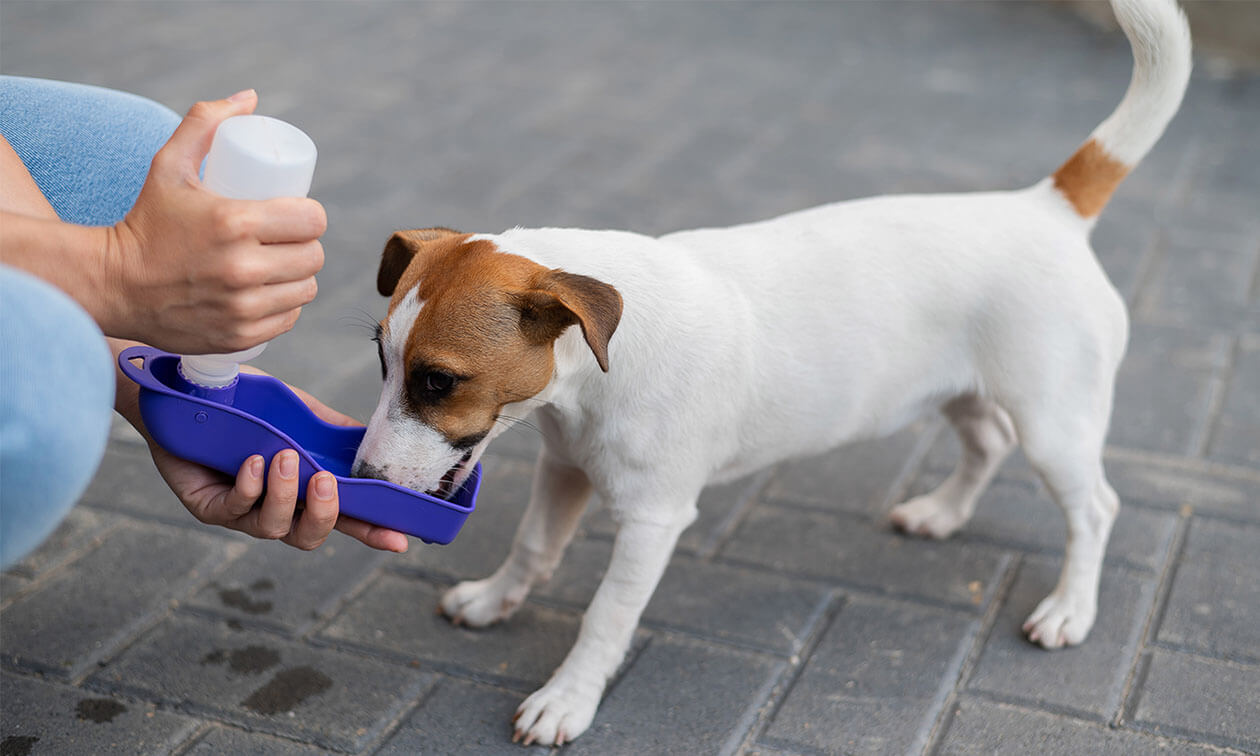Did you know that 60% of an adult dog's body weight, and as much as 70% to 80% of a puppy's body weight, is water1,2? Without proper hydration, your dog's body can't function properly. That is why it's so important to recognize the early signs of dehydration in your dog.
What Happens When Your Dog Gets Dehydrated?
When your dog is dehydrated, their body loses more water than it's taking in. There's a reduction in the volume of fluids and blood flow. This results in decreased oxygen delivery to the organs and tissues. Additionally, an imbalance occurs with the body's electrolytes (sodium, chloride, and potassium) that affects the ability of the muscles and internal organs to function properly.
Dogs can develop symptoms of dehydration quickly, and things can go from mild to serious before you realize it. When dogs become seriously dehydrated, there's a risk of organ failure and death.
Causes of Dehydration in Dogs
Dehydration can occur for many reasons, including:
- Not drinking enough water, either from lack of access or refusing to drink. They can be refusing to drink due to illness, such as nausea or behavioral reasons.
- Loss of fluids from vomiting, diarrhea, increased urination, excessive panting, etc.
- Nursing dogs not getting enough water to replenish the fluids being lost through nursing.
- Underlying medical issues such as diabetes, kidney disease, and cancer that would make them drink and urinate more.
- Extreme heat. Dogs do need to drink more in the hot weather to avoid dehydration.
At-Home Tests to See If Your Dog is Dehydrated
Your dog can't tell you when they're thirsty or feel dehydrated. Instead, they rely on you to recognize dehydration's subtle and early signs.
- Try the skin tent test. This is a quick and easy test you can do to determine if your dog is dehydrated. Practice this test when you know your dog is well hydrated, so you'll know what's normal for their skin. You gently grasp and lift the skin over your dog's shoulder blades and then let it go. Carefully evaluate how the skin falls back into place.
The skin will quickly snap back into its original position if a dog is well-hydrated. When they are not well hydrated, the skin stays tented, falling back into place more slowly. Remember, by the time your dog has tented skin, they're already dehydrated to the point that their internal organs are experiencing damage.
This test can be more difficult to read if you have a wrinkly breed like a Bulldog. Some dogs naturally have looser skin even when hydrated, like seniors. If you're concerned about dehydration, contact your veterinarian or emergency veterinary clinic right away.
- Try the gum test. Your dog's gums can be a good indicator of mild dehydration. First, check the color and wetness. Are the gums pink and moist or dry and tacky? When dogs are mildly dehydrated, their gums become dry and tacky.
Next, look at their capillary refill time to determine how quickly the capillaries in the gums refill with blood. To perform this test, gently press your finger against your dog's gum and remove it. The area pressed will look white. If it returns to the normal pink color quickly (less than two seconds), your dog likely has normal blood flow3. The capillary refill time will be longer than two seconds in dehydrated dogs3.
Physical Signs of Dehydration in Dogs
You can look for these signs of mild dehydration, including:
- Lethargy or decreased energy levels. They don't have the energy or desire to move around, which may result from lowered blood pressure from dehydration.
- Sticky gums. As your dog becomes dehydrated, their mouth loses its wetness.
- Panting excessively. Dogs pant when they are hot and may need more water.
- Acting confused, stumbling, or tripping.
If you notice any of these signs, take immediate action. Encourage your dog to drink cool, clean water and call your veterinarian for treatment recommendations.
The symptoms you may notice when your dog is moderately dehydrated may include the following:
- Loss of skin elasticity. Due to a lack of moisture, dehydrated skin does not return to its normal position quickly following the skin tent test.
- Loss of appetite. This can indicate other serious medical issues which can worsen dehydration.
- Dry gums. This is evident in the later stage of moderate dehydration. Veterinary care is essential if your dog's gums are very dry (progressing well beyond tacky).
Immediate veterinary care is needed if you notice any of these symptoms of severe dehydration:
- Vomiting. This occurs with severe dehydration and will make the dehydration worse.
- Diarrhea. This is another symptom that can actually make dehydration worse.
- Excessive panting. Your dog will appear to have difficulty breathing. You will notice their sides heaving and their tongue hanging out.
- Sunken, dry-looking eyes. Your dog's body will redistribute fluids to more essential organs to ensure adequate blood flow. The eyes are one location fluids are pulled from. They will appear to be sitting farther back in the eye socket.
- Increased heart rate. A dog's normal heart rate is 70–120 beats per minute (toy/small breed dogs can handle a slightly higher rate). When they are dehydrated, their heart rate increases for more than 30 seconds. A sustained heart rate greater than 160 beats per minute means you must seek immediate veterinary care. The situation becomes extremely critical if their sustained heart rate reaches 250 beats per minute.
- Acting confused or disoriented.
- Extremely dry, dark red, or pale gums. This results from low blood volume and the passage of blood through the capillaries. The body may also try to cool itself by increasing blood flow to the limbs.
- Collapse. This occurs due to shock when your dog's circulatory system fails, and essential organs do not receive sufficient oxygen.
It sounds scary, because it can be, but if you're familiar with the early signs of mild dehydration, you can catch and address it quickly before things become serious.
ZPC-02531
- Applied Physiology of Body Fluids in Dogs and Cats. Maxey L. Wellman, Stephen P. DiBartola, Catherine W. Kohn. https://veteriankey.com/applied-physiology-of-body-fluids-in-dogs-and-cats/. Accessed 10/26/2022.
- Fluid Calculations: Keeping a Balance. Today’s Veterinary Nurse. https://todaysveterinarynurse.com/internal-medicine/fluid-calculations-keeping-a-balance/. Accessed September 29, 2023.
- Small Animal Critical Care Medicine. Tim B. Hackett DVM, MS, DACVECC. 2nd edition. 2015.



